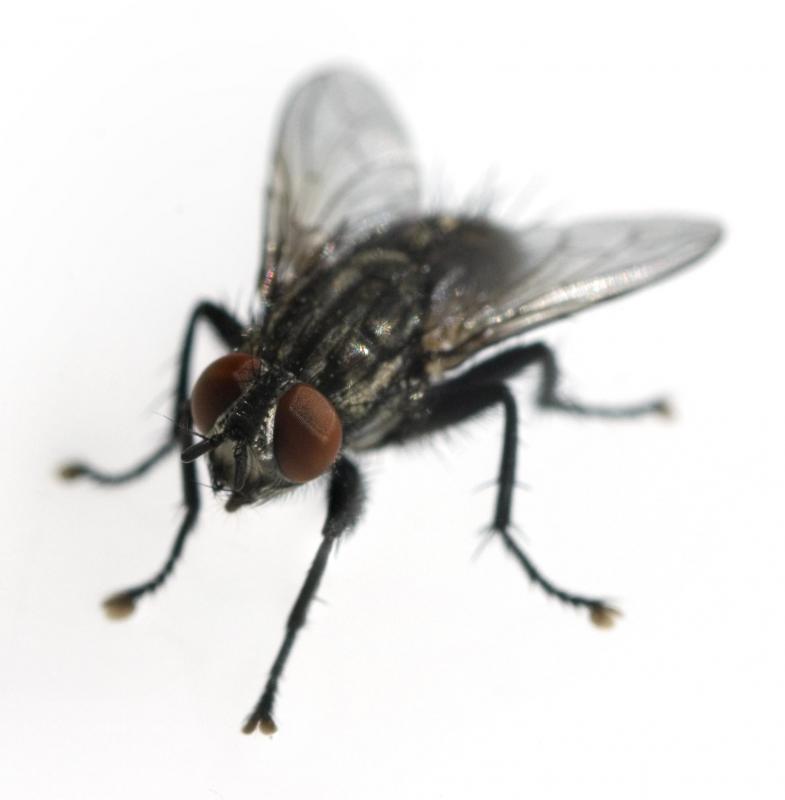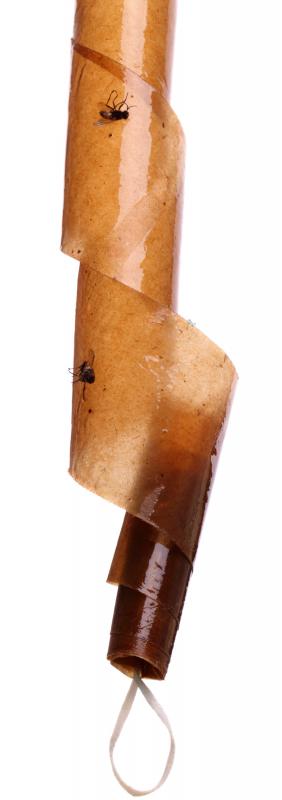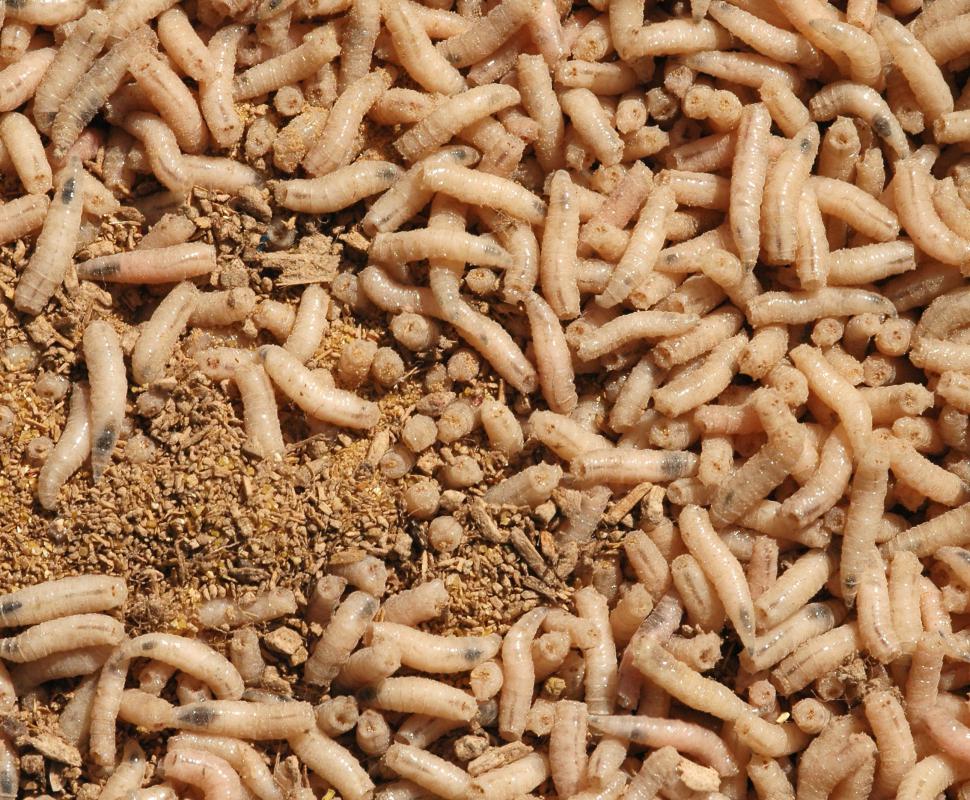At AllThingsNature, we're committed to delivering accurate, trustworthy information. Our expert-authored content is rigorously fact-checked and sourced from credible authorities. Discover how we uphold the highest standards in providing you with reliable knowledge.
What is a Housefly?
The housefly (Musca domestica) is one of the most common and widely dispersed nonbiting insects in the world. Appearing close to human populations, the housefly is a major factor in the transmission of several serious diseases.
Houseflies belong to the Order Diptera (having two wings). They are insects, possessing the standard three-part body composed of a head, a thorax, and an abdomen. The body of the housefly, a hard exoskeleton, is covered with minuscule hairs. They have six articulated legs, also covered with hairs. There are sensory receptors for smell and taste distributed on the legs and feet of the housefly, and also on their mouthparts.

Adult houseflies typically attain a size of no larger than 1/2 inch (1.25 cm), with the females surpassing the males in size. The thorax is dark gray, with four dark lines running lengthwise down the back. The ventral side of the abdomen is yellow. Houseflies have compound eyes, which are made up of several visual units. Because compound eyes are not focused, the vision of the housefly is blurred.

Houseflies multiply at a staggering rate. In only approximately two weeks from egg to adult, a female will be ready to lay eggs — almost 500 of them. She will lay her eggs in batches of about 100 to 150, over a period of three to four days. Her egg-laying medium of choice will be something the larvae can feed on upon hatching. Typical breeding grounds include garbage, rotting food, exposed feces of any type, and decomposing animal carcasses. The eggs have to stay moist in order to hatch successfully.

Within less than one day (8 to 20 hours), the whitish larvae, called maggots, hatch and begin to eat. A full-grown maggot will attain its mature size — 0.3 to 0.5 inch (7 to 12 mm) — in about three days. Larvae will be completely developed and ready to pupate in anywhere from four to thirty days, depending on the temperature of their environment. The more optimal the temperature, the quicker their development.
Similarly, the development of the housefly pupae depends on environmental temperature. In optimal conditions, only two to six days are required for the housefly to emerge from the pupal case.

In ideal conditions, the life cycle of the housefly may be completed in as little as ten days. Under more challenging conditions, it may take as long as two months. The average life cycle of the house fly takes place in ten to twenty-one days. Anywhere from ten to twenty generations of houseflies may occur in a given year.
This prodigious capacity for reproduction makes the housefly a formidable foe in the war against illness and disease. The housefly is frequently a carrier for typhoid fever, anthrax, dysentery, and cholera, among other serious illnesses. It transmits disease by picking pathogens up on its leg hairs and then depositing them on food, contaminating it, when it lands there.

Possessing sponging, sucking mouthparts, houseflies can consume only liquid foods. To do so, they regurgitate on their food, which allows digestive enzymes to liquefy the food so they can ingest it. This process transfers germs from the housefly’s stomach contents to whatever it happens to land on and eat—particularly problematic if this is food about to be consumed by a human.
In spite of their role as disease carrier and general annoyance, houseflies do perform some useful functions. They serve as food for spiders and birds, they act as scavengers to help consume dead animals and rotting waste, and they are effective pollinators.
Houseflies should not be confused with stable flies, or dog flies. Stable flies feed on blood and cause raw, irritated wounds. Dogs that spend a great deal of time outdoors may be prime targets for these flies. Blow flies or flesh flies are large, slow, shiny green or blue flies that may also be confused with houseflies. These flies prefer freshly dead animals and are a good indicator of a dead animal in the proximity. They do not bite.
Frequently Asked Questions
What is a housefly and where can it typically be found?
A housefly, scientifically known as Musca domestica, is a common insect that thrives in human habitats worldwide. They are ubiquitous in homes, farms, and garbage disposal areas, where they have access to food waste and other organic materials. Houseflies prefer warm climates and are most active during the day.
How long is the lifespan of a housefly?
The average lifespan of a housefly is around 28 days, although this can vary depending on environmental conditions. In their short lives, they progress through a complete metamorphosis: starting as eggs, then larvae (maggots), pupae, and finally emerging as adult flies. Rapid reproduction means populations can quickly escalate in suitable conditions.
What do houseflies eat and how do they feed?
Houseflies are omnivorous scavengers, feeding on a wide range of liquid or semi-liquid substances, including human food, animal feed, and decaying organic matter. They feed by regurgitating saliva onto solid food to pre-digest it, then sucking up the resulting mixture. This process can spread diseases, making them a health concern.
Are houseflies dangerous to humans?
Houseflies are considered a health hazard because they can transmit over 100 pathogens, including those causing typhoid, cholera, and tuberculosis. They pick up bacteria, viruses, and parasites from feces, trash, and other contaminated sources, then transfer these to human food and surfaces. Proper sanitation and fly control measures are essential to minimize their impact.
How do houseflies reproduce and how fast do they multiply?
Houseflies reproduce by laying eggs, usually in warm, moist, and nutrient-rich environments like compost or manure. A single female can lay up to 500 eggs in her lifetime, which can hatch within 24 hours under optimal conditions. This rapid reproduction rate can lead to large infestations if not properly managed.
What are some effective ways to control housefly populations?
Controlling housefly populations involves sanitation, exclusion, and sometimes chemical interventions. Keeping living areas clean, sealing garbage, and using screens on windows and doors can prevent flies from breeding and entering homes. Insecticides and fly traps can also be used, but should be applied carefully to avoid harm to humans and non-target species.
AS FEATURED ON:
AS FEATURED ON:















Discussion Comments
I have read in a magazine that because flies have compound eyes they can detect movement much faster than humans can.
The speed at which they can fuse separate images into one is about five times greater than ours. That fact allows them to zoom around at an incredibly fast pace without crashing. And that is also the reason why they are so difficult to catch. They can see us coming.
Post your comments